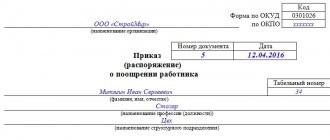Why do you need an order for appointment to a position?
The employment of any employee is formalized by an employment contract and a hiring order (Article 68 of the Labor Code of the Russian Federation). Based on the order:
- a personnel number is assigned;
- a personal card is created;
- An entry is made in the work book (SZV-TD is submitted no later than the day following the hiring).
The standard form for an acceptance order is the unified form T-1, introduced by Resolution of the State Statistics Committee of January 5, 2004 No. 1.
The appointment of any employee to a position reflects an employment order. But the assumption of a position by a manager (for example, director or chief accountant) is accompanied by the issuance of an order of appointment to the position, which is classified as documents related to the main activity.
Read about how to issue an order to hire several employees at once here.
The first part of the T-5 form
In the specified section of the form the following is filled out:
1) Full name of the enterprise.
2) OKPO code.
3) Registered document number.
4) Date it was filled out.
Under the title of the form, fill out the fields indicating:
5) Transfer dates.
6) Dates for completion of the new job (if the assignment is temporary). When moving a subordinate on a permanent basis, put a dash in the date column “to...”.
The following lines display:
7) Full name a subordinate being transferred to another vacancy.
Personnel number of the specialist (if available).
9) Type of movement.
What is the difference between an order for appointment to a position and an order for employment?
What is the difference between these documents? Controllers, banks, and other authorities may require a document on the basis of which one or another person exercises authority on behalf of the organization (and sometimes on behalf of the individual entrepreneur). If you issue an employment order to the director, the situation will look like the employment of an ordinary employee, but this is not entirely true.
The main differences between the documents are:
| Document | The order of acceptance to work | Order on appointment (assuming) to a position |
| Documentation category | By main composition | By main activity |
| For which employees is it issued? | For everyone except managers | For management |
| Form | Independently developed by the employer or standard T-1 | Independently developed by the employer, since T-1 does not contain a reference to taking up a position |
| Foundation of the publication | Employment contract | Employment contract. For the director - also the decision of the founders (or the decision of the sole owner, who takes office himself) |
Responsibilities of the contract manager
In the process of fulfilling his duties, the contract manager, as we have already said, assumes the entire range of responsibilities associated with the preparation, planning and implementation of the purchase.
For example, procurement responsibilities performed by a contracting service may be distributed among service employees, with each of them being responsible for a separate area of procurement, for example, planning.
As for the contract manager, he is responsible for all tasks, from planning to final implementation.
How to draw up an order for appointment to a position
The form of such an order is fixed in the accounting policy (clause 4 of the Regulations, approved by Order of the Ministry of Finance dated October 6, 2008 No. 106n). It can be developed from scratch or based on the T-1 form.
Basic details of the order to take office:
- employer's name;
- title “Order on taking office”;
- date and document number;
- employee's full name;
- position according to the staffing table;
- the date of assumption of office and the date of expiration of powers (if a certain period is established);
- basis for registration;
- signature of the manager or other authorized person, his position and transcript;
- signature of the employee who has read the document.
The manager has the right to sign an order for himself (Letter of Rostrud dated March 11, 2009 No. 1143-TZ). Additional argument: the order is issued in the presence of a signed employment contract and a decision of the owners, i.e., by the time the administrative document is signed, the director has the authority to sign it.
If the manager combines his functions with the responsibilities of the chief accountant, this is also recorded in the order for taking office. It is important that the provisions of the order do not contradict the employment contract.
Order form
From January 1, 2013, the forms of standard primary documents were canceled for mandatory use, except for some (letter of the Ministry of Finance of the Russian Federation No. PZ-10/2012).
Therefore, today enterprises can use a template for orders for transfer to another vacancy, developed independently. At the same time, many enterprises continue to use the previous standard template for an order to transfer an employee - T-5 (T-5a - when transferring several employees).
Regardless of the chosen order template, T-5 or generated in a custom style, this order must include the following information:
- Name of the institution and its details.
- Document number and date of publication.
- Position and full name specialist who is being transferred.
- What vacancy the employee is being transferred to.
- Reason and date of appointment.
- Full name of the director who signed the order.
Note : The appointment of a subordinate to another vacancy should not be confused with his appointment to another place of work (clause 3 of Article 72.1 of the Labor Code of the Russian Federation), which does not change his obligations and working conditions.
Types and reasons for transfer
The Labor Code of the Russian Federation provides for the following methods of moving along the crankcase ladder for an employed person to another vacancy:
- Temporary.
- Constant.
1) You can temporarily move a subordinate to another vacancy in the same company for a period of up to 12 months. If a person remains in a transferred position for more than the specified period, then this refers to a permanent appointment. To temporarily assign an employee to another vacancy, his consent will be required, with the exception of certain points, namely:
- A disaster that threatens the life of the population.
- Accidents at the enterprise.
- An accident at the company.
- Downtime of an object that may lose its status due to the absence of a working person, or due to a man-made accident.
In the presence of the listed factors, the duration of personnel reshuffle can be carried out up to 30 days. At the same time, when transferring to a vacancy at a lower level, a specialist’s written approval is required, provided that the salary remains unchanged.
2) A permanent transfer to another vacancy can only be carried out with the consent of the employed person. At the same time, in this case, the legislation of the Russian Federation also provides for a forced transfer procedure. These may include circumstances:
- When a specialist cannot occupy the previous vacancy due to a medical prescription.
- When reducing the number of personnel.
In these circumstances, the law does not provide for the consent of an employed person to move him to another vacancy.
All orders published by the head of the enterprise must have a basis for their publication. The grounds may be a specialist’s petition, or a memo from the department’s management, which notes compelling arguments for making the appointment.
Note : When appointed to another vacancy on the initiative of management, the employee is required to send a preliminary notice of the planned change in his future.
Who is drafting the document?
At enterprises, the preparation of orders for the transfer of specialists is usually carried out by employees of the personnel or legal departments (if any), the management staff of structural departments, and in small companies, secretaries or the directors themselves.
At the same time, regardless of who prepares the order, it must be signed by the manager, and also, the administrative document must be familiarized with the signature of the specialist who is being transferred.
Sample order for appointment to a position
Taking into account our recommendations, the document looks like this:
Sample order for appointment to a position
Useful information from ConsultantPlus
See also:
– Sample order for appointing an employee to a position.
– Sample order for appointment to the position of chief accountant.
Can a director work part-time? Read the material.
Content requirements
So, let’s figure out what is important to take into account when drawing up the order “Contract manager under 44 Federal Laws,” a sample of which you can download below. The document must contain the following information:
- Link to Article 44-FZ on the appointment of a person responsible for public procurement.
- Last name, first name, patronymic, position of the appointed official.
- Functions and assigned powers, reflecting the timing of their implementation.
- Information about whether the employee will be responsible for all purchases or only a specific area.
- The person responsible for executing the order.
- Signatures of the manager and designated persons.
The document is drawn up by an authorized official and approved by the manager. An important point is that when choosing a manager, the customer must make sure that he has a higher education, as well as additional professional education in the field of procurement (Part 6 of Article 38 of 44-FZ).
Let's sum it up
- An order for appointment to a position is issued in relation to employees holding managerial positions and refers to documents on the main activities of the enterprise.
- The order on taking up a position largely repeats the standard order on hiring; it is distinguished, first of all, by its name - “Order on appointment to a position.”
- The document on the appointment of a manager may be signed by the manager himself.
- The basis for issuing the order is the employment contract, and in relation to the manager - also the decision of the founders.
Types and reasons for transfer
The Labor Code provides for temporary and permanent transfers. Temporary work is done for another job, but with the same employer. Such an appointment may be for a period of no more than 1 year. If an employee holds a temporary position for more than this time, the shift becomes permanent. A temporary appointment must be agreed upon with the employee, unless it is due to the following factors:
- a natural or man-made disaster that threatens the life of the entire population or part of it;
- industrial accident;
- industrial accident;
- downtime of equipment or property that may deteriorate due to the absence of an employee;
- downtime of equipment or property that may deteriorate due to man-made or natural reasons.
In such cases, personnel reshuffle can be carried out for a period of no more than one month. However, assignment to work requiring lower qualifications can only be made with the written consent of the employee. As for remuneration, it cannot be lower than the average salary for the previous job.
A permanent transfer can only be made with the consent of the employee. But even in this case, the legislation provides for mechanisms for forced change of position. For example, when an employee can no longer carry out his work activities due to health reasons and this is confirmed by a medical certificate. Another case is when a company is downsizing, resulting in personnel changes.
Please note that the employee’s consent is not required when moving from the same employer to another workplace or structural unit located in the same area. And also when entrusting work with other devices and mechanisms, if this does not contradict the terms of the employment contract.







